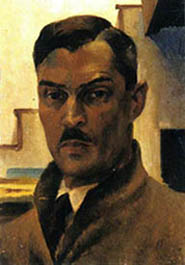Product Description
Victor Arnautoff “The Felt Hat” Oil on Canvas c. 1930


VICTOR ARNAUTOFF (1896-1979) USA
The Felt Hat c. 1930
Oil on canvas, white gold frame
Signed: V. Arnautoff, lower right
Exhibited: Art Center San Francisco, 1931 (see image of the review in the San Francisco Examiner, July 12th, 1931)
For more information see: The New Deal for Artists, Richard D. McKinzie (Princeton, NJ: Princeton University Press, 1973), Coit Tower, San Francisco : Its History and Art
Painting: H: 26” x W: 21”
Framed: H: 32 ½” x 27 ½”
Price: $60,000
Victor Arnautoff created paintings and watercolors, focusing on portraits, still lifes and rural landscapes in his early years, and moved to more socially conscious themes later in his career. Arnautoff was a native of Russia, to which he returned during the 1960s after thirty years in the United States. He came to San Francisco from Russia via China, bringing his wife and children with him, and studied at the California School of Fine Arts studying with Ralph Stackpole and Edgar Walter before going to Mexico. There he worked as an assistant to the famous Mexican muralist Diego Rivera. During the 1930s, Arnautoff worked as project director and one of the artists selected to create the famed Coit Tower murals, he played a key role in determining the political and social content of the frescoes painted in the San Francisco landmark. His own contribution, City Life, appears to be a lively, non-political melding of downtown San Francisco scenes; however, closer study reveals two leftist newspapers on the newsstand, while the city’s most mainstream daily, the San Francisco Chronicle, is strangely missing. Arnautoff also painted frescoes in the Military Chapel at San Francisco’s Presidio, in the Anne Bremer Library of the San Francisco Art Institute, and in high schools and other buildings in the Bay Area. He was a professor of art at Stanford University from 1939 until his retirement in 1963.
Victor Arnautoff “The Felt Hat” Oil on Canvas c. 1930
You must be logged in to post a comment.
GERTRUDE BURGESS MURPHY (b. 1899) USA
Reclining nude sculpture c. 1950
Fired and glazed earthenware on a wooden base
Marks: original paper exhibition label (San Francisco Museum of Art, Rental Gallery); tape with the name of the artist
For more information on Murphy see: Who Was Who in American Art, ed. Peter Hastings Falk (Madison, Conn.: Sound View Press, 1985), p. 439.
H: 5 7/8” x L: 10 5/8” x D: 5”
Price: $11,500

Reviews
There are no reviews yet, would you like to submit yours?